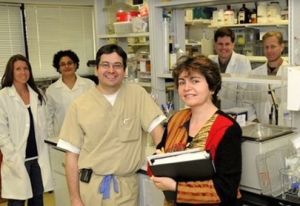27 March 2014. A pharmacologist at George Washington University in Washington, D.C. developed a technique to produce heart muscle tissue from an individual’s stem cells that helps weak veins return blood back to the heart. The creator of the process, GWU medical school professor Narine Sarvazyan, discussed the technology in a recent online issue of the Journal of Cardiovascular Pharmacology and Therapeutics (paid subscription required).
A provisional patent has been filed for the technology, with Sarvazyan listed as inventor. And the university is already promoting the technology for licensing.
The technique is designed to treat patients with chronic venous insufficiency, a condition where the veins, particularly in the legs are weakened and valves in the veins are not able to pump sufficient blood back to the heart. Symptoms include swelling of legs and ankles, aching or tiredness in the legs, varicose veins, and flaking or itching skin on the legs or feet.
The condition can worsen over time, and lead to ulcers on the skin, which are prone to infection. According to the Cleveland Clinic, some 40 percent of Americans are believed to have some form of chronic venous insufficiency, particularly those over the age of 50.
Sarvazyan’s process creates small pieces of heart muscle that are wrapped like a cuff around the veins of patients with weakened valves. The engineered heart muscle, like natural heart muscle tissue, beats rhythmically, giving a boost to the veins’ ability to direct the blood to the heart. The engineered heart muscle is cultured from the patient’s own stem cells, thus preventing rejection of alien tissue.
Sarvazyan and colleagues from her lab demonstrated the feasibility of the technology in the lab, and further tests are planned with lab animals. The following brief (5 second) lab video shows the engineered heart tissue in operation.
- Implanted Heart Membrane Device Created by 3-D Printer
- Chip Designed to Capture Images Inside Heart, Blood Vessels
- EU-Funded Project to Develop Biomaterials for Stents
- Heart Vessel Surgical Glue Shown Effective in Animal Tests
- NIH Funding Micro-Sutures for Stem Cell Heart Muscle Repair
* * *


 RSS - Posts
RSS - Posts
You must be logged in to post a comment.